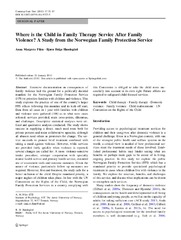| dc.contributor.author | Flåm, Anna Margrete | |
| dc.contributor.author | Handegård, Bjørn Helge | |
| dc.date.accessioned | 2016-03-21T09:34:47Z | |
| dc.date.available | 2016-03-21T09:34:47Z | |
| dc.date.issued | 2015-01-21 | |
| dc.description.abstract | Extensive documentation on consequences of family violence laid the ground for a politically decided mandate for the Norwegian Family Protection Service (FPS) to prioritize families with children and violence. This study explores the practice of one of the country’s larger FPS offices following this mandate and its kick-off start. Data from all cases in 1 year with families with children and violence were gathered (106) as to what were cases referred, services provided, main cross-points, dilemmas, and challenges. Descriptive statistical analyses were utilized and qualitative analysis conducted. The study shows success in supplying a direct, much used route both for private persons and main collaborative agencies, although all abusers need others as promoters for change. The service succeeds to pioneer brief treatment combined with taking a stand against violence. However, while services are provided fairly quickly when violence is reported, several changes are called for: A more violence-sensitive intake procedure, stronger cooperation with specialty mental health service and primary health service, extended use of assessment tools and outcome measures. Given the nature of violence, particularly follow up measures are required. However, first and foremost, the study calls for a better inclusion of the child. Despite mandated priority, a major neglect of children takes place. In line with the UN Convention on the Rights of the Child, the Norwegian Family Protection Services in a country complying with this Convention is obliged to take the child more successfully into account in its own right. Future efforts are required to safeguard child-focused services. | en_US |
| dc.description | Published version. Also available at Springer via <a href=http://doi.org/10.1007/s10591-014-9323-5>http://doi.org/10.1007/s10591-014-9323-5</a>. | en_US |
| dc.identifier.citation | Contemporary family therapy 2015, 37(1):72-87 | en_US |
| dc.identifier.cristinID | FRIDAID 1292317 | |
| dc.identifier.doi | 10.1007/s10591-014-9323-5 | |
| dc.identifier.issn | 0892-2764 | |
| dc.identifier.uri | https://hdl.handle.net/10037/9043 | |
| dc.identifier.urn | URN:NBN:no-uit_munin_8613 | |
| dc.language.iso | eng | en_US |
| dc.publisher | Springer | en_US |
| dc.rights.accessRights | openAccess | |
| dc.subject | Child therapy | en_US |
| dc.subject | Family therapy | en_US |
| dc.subject | Domestic violence | en_US |
| dc.subject | Family violence | en_US |
| dc.subject | Child maltreatment | en_US |
| dc.subject | UN Convention on the Rights of the Child | en_US |
| dc.subject | VDP::Medisinske Fag: 700::Klinisk medisinske fag: 750::Psykiatri, barnepsykiatri: 757 | en_US |
| dc.title | Where is the Child in Family Therapy Service After Family Violence? A Study from the Norwegian Family Protection Service | en_US |
| dc.type | Journal article | en_US |
| dc.type | Tidsskriftartikkel | en_US |
| dc.type | Peer reviewed | en_US |


 English
English norsk
norsk


